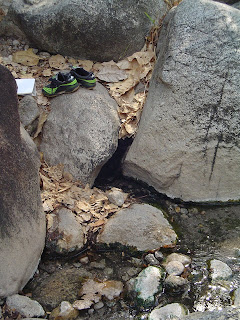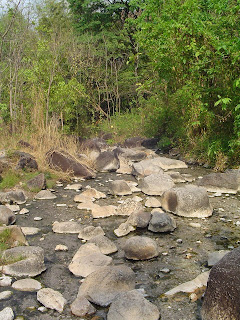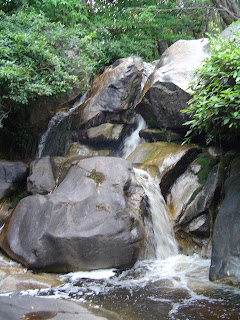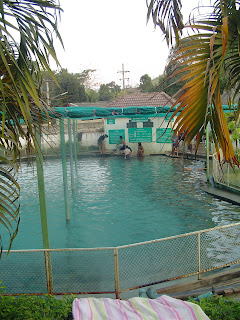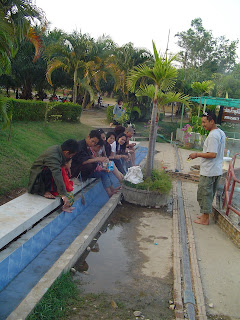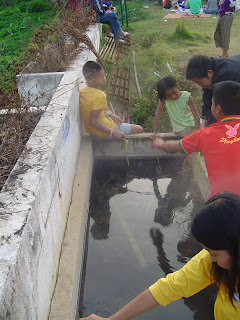 Loy Krathongs for sale at the hot springs entrance. These 'rafts' made from banana leaves and flowers are released on rivers and or ponds during the full moon of November.
Loy Krathongs for sale at the hot springs entrance. These 'rafts' made from banana leaves and flowers are released on rivers and or ponds during the full moon of November. 'Many Thai believe that floating a krathong will create good luck'.
The day of my visit co-incided with the last day of Loy Krathong celebrations which are celebrated elaborately in these surroundings.Many hot springs in Thailand (or elsewhere in Southeast Asia) tend to be elusive. Largely undeveloped, they have little value for the 'outsider' it's presumed. Contrary to this, the hot springs of Phra Ruang (or Bueng Sap) are easy to be found. From nearly every nook or cranny of Kamphaeng Phet province (Central Thailand) signboards have been erected directing all those wishing to do so to proceed without delay. So, this time no long story about how we eventually find this hot spring.
Entering
Instead, after following the signboards we draw up at an extensive parking area, which obviously is the place. There a few stalls, selling drinks and / or snacks situated around the parking area, as well as a massage place (not open) and a stall selling Loy Krathongs (see photo above blog entry) for the following evening.
 Grand entrance
Grand entrance
Surprisingly just before the temple, one can have one's picture taken which is then attached to a commemorative plate: Soaking in Southeast Asia was here! Tacky souvenir?
Entrance temple
The temple is, I believe, dedicated to King Naresuan, once ruler of the empire of Thailand (during the Ayutthaya period) who, time and again, managed to defend his kingdom from a Burmese onslaught. His name is tied in with the symbol of the fighting cock, as when he was young and held captive in Burma: 'At one point, the Burmese Crown Prince challenged Prince Naresuan to a game of fighting cocks which resulted in the Crown Prince losing his bird and bet. In anger, frustration and jealousy the Crown Prince exclaimed "This vassal of a cock is really impudent". To which Prince Naresuan responded "Not only can this cock bet for money, it can also fight for kingdoms"!Source
 The temple with it's roosters
The temple with it's roosters
Ploy?
The establishment of this temple seems to be part of a ploy to popularize visits to the hot springs.
Likewise the new name of the hot springs, Phra Ruang, refers to the Phra Ruang dynasty, the first ruler of which, King Sri Indraditya,'... declared independence of his territory from Khmer control [Angkor Wat] and its prohibitive taxes, ...'
In so doing, he established the Kingdom of Sukhothai, which managed to expand well beyond the current borders of Thailand. He was thus referred to as Phra Ruang, the Glorious Prince. History lessons @ Soaking in Southeast Asia, tout gratuit!
But what has this to do with the hot springs? Well, as said, there seems to be ploy to attract (domestic) tourists, with the temple and with the name change; previously the hot springs used to be called Bueng Sap, which translates as 'wealthy swamp'. Now, that doesn't sound very attractive, however accurate it may have been. The grounds
After strolling the 50 meters or so, on the right is large half open building. There's a desk with a lady behind, a fridge for drinks and some snacks are for sale. Otherwise there are many exhibition cases, most showing the change from what it was (a swamp with lot's of reeds) into the 'showcase' of now: a walled-in case of concrete and water!
 Exhibit no. 1: Photo of 4 local (?) belles (?) soaking in one of the brand new private soaking cubicles
Exhibit no. 1: Photo of 4 local (?) belles (?) soaking in one of the brand new private soaking cubicles Healthy?
The reason for the change in settings is due to the perception that the waters here, are some of the best in all Thailand. Citing the Tourism Authority of Thailand's (TAT) Kamphaeng Phet leaflet (of July 2008): 'In accordance with an examination by the [Thai] Ministry of Public Health, it contains neither contaminated substances nor diseases which are dangerous'.
Which a relief, but is it a real endorsement? Actually despite not citing any positive about the waters, these hot springs are being promoted as a 'health tourism destination', another one of former Thai PM Thaksins idea's. This site though adds: '..., historical belief tells that water from hot spring [Phra Ruang] can be used to cure several illness; such as muscle aches'
Muscle aches, but does not hot water always do this?
However, Thailand Energy end Environment Network in it's 'Potential hazards of pollutants in Thai hot springs', cites cases of Legionell pneumophila found at Phra Ruang, but adds:'... they might have affected a relatively large number of persons exposed but not be recognized as the cause of disease (Legionaires' disease and Pontiac fever)'.
 Exhibit no. 2: 92 year lady attributes her health at her age to the waters of Phra Ruang. It's in the newspaper, so it's true!
Exhibit no. 2: 92 year lady attributes her health at her age to the waters of Phra Ruang. It's in the newspaper, so it's true!
'This hot spring is a natural phenomenon, emerging from underground through 5 spots. The temperature of the water is around 40-65C.
...
Currently the surroundings of this Phra Ruang Hot Spring have been renovated and serve as a health tourism destination and a relaxation venue'.
It's good, this assurance, of a 'natural phenomenon' as there's not much natural to the surroundings anymore.
How to get healthy?
Ongoing from the main building are about 5 'cubicles' (see photo's above) where you can bathe behind a locked door! Safety first.
Then there's a huge pond with a spouting fountain. Between the pond and the main building are a number of 'tubs' in a broad concrete plain, some containing hot water.
Then finally around a corner, a small shallow pond flanks the larger pond. In it, you can soak your feet, what a great idea. A 15 minute soak is sufficient.  Phra Ruang, a great place to soak sore feet?
Phra Ruang, a great place to soak sore feet?
Surroundings
The direct surroundings of the hot springs are low rolling hills, planted mostly with cassava, corn, sugarcane or, in more wetter area's, rice. To the north lie the mountains of Ramkhamhaeng National Park. A great place to waste time, much better than the hot springs themselves, to tell you the truth. Especially the falls of Sai Roong, though like visiting the hot springs, you'll need your own wheels.The best place to stay nearby is the provincial capital with the same name, Kamphaeng Phet, a former outpost of the Sukhothai kingdom. Though Sukhothai is also not too far away. One option is to stay at the Scenic Riverside Resort (beware, terrible accompanying music when accessing this website!) in Kamphaeng Phet; one of the best resorts I've stayed in ever, located in Kamphaeng Phet town itself. The bungalows are relatively cheap and are huge. The grounds are beautiful and the resort has real character. It includes a pool and the Ping river flows right in front of the resort.
Kamphaeng Phet town, is also located near a few national parks (N.P.) towards the Burmese border, such as Klong Lan N.P. and Klong Wang Chao N.P. And like in Sukhothai, the Loy Krathong festivities are a great time to spend a couple of days here. Getting There: As stated the springs are well sign boarded. A precise route is to follow Highway 101 north (towards Sukhothai) out of Kamphaeng Phet town for 13 km's and then a left and 12 km's up this road you'll come upon the springs, can't be missed.
Soaking Experience: Well, regular readers of this blog will know that I prefer more natural settings and tend to dislike being hemmed in by 4 walls. As such I didn't take a full soak; besides it was just past lunch time, the hottest part of day. Maybe in the evening I would have been tempted to soak, but that wasn't the case. The feet soak though was not too bad, considerable effort had been awarded to making the site as comfortable as possible.
Overall Impression: Compared to the 'before' situation, the upgrading of the site may have been a little over the top. However, the old situation did not look tempting either. The main point though was that while I was visiting there were quite a few Thai visitors which at least gave the expansive site some character., though it still felt deserted which is quite uncommon on a national holiday. Then again we've seen better, but in the surroundings of the northern parts of Thai plains (where Kamphaeng Phet lies), there are hardly others.
 Charming park?
Charming park?
Visited October 2008.




